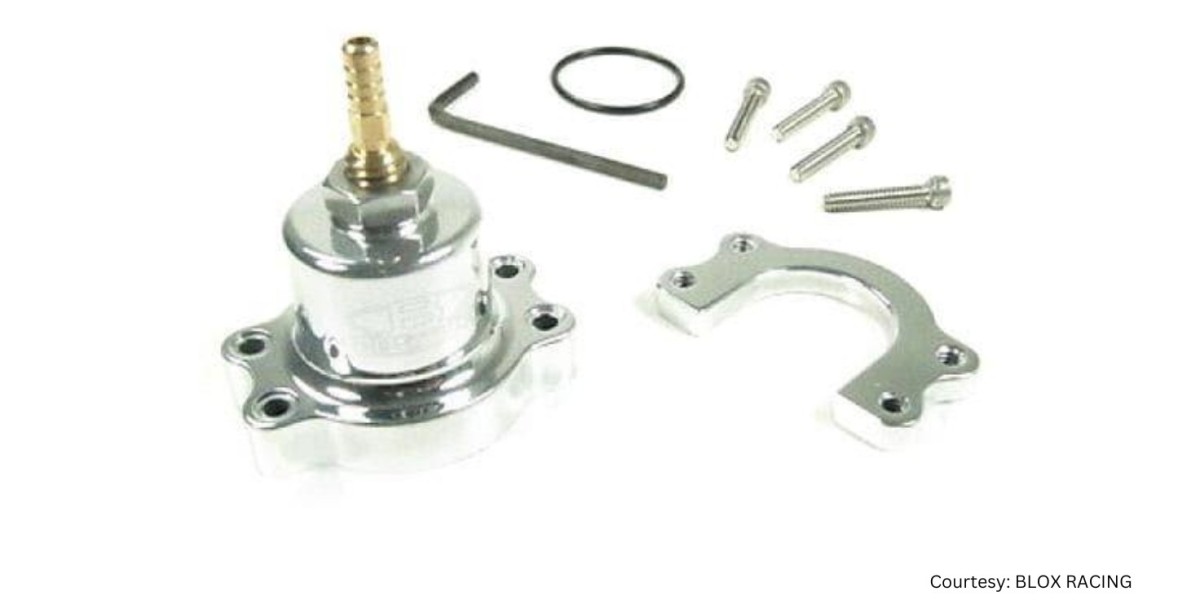Every part is used to ensure optimum engine performance, and an upgraded car is used for better performance. One crucial component usually overlooked in high-performance fuel systems is the adjustable fuel pressure regulator. A BLOX Racing adjustable FPR is an affordable and hassle-free alternative that can be substituted for those overly complicated and overpriced after-market units.
This billet aluminum piece is installed on the factory fuel pressure regulator, making it an adjustable unit so that users can properly tune the air/fuel ratio. This is ideal for any aftermarket products requiring a bump in fuel pressure. It is designed to work with the factory fuel rail.
Range: 25-60psi
NOTE: Modifying the factory fuel pressure regulator and/or fuel rail is required. Vehicle Applications
- 88-00 Honda CRX, Civic, Del Sol
- 90-01 Acura Integra
- 91-UP Acura NSX
- 92-02 Honda Accord (4-cyl)
- 92-01 Prelude
- 00-05 Honda S2000
This article will discuss how adjustable fuel pressure regulators work, why they are essential, and how they improve overall vehicle performance.
What is an Adjustable Fuel Pressure Regulator?
It is a part of the fuel system that controls the fuel pressure supply to the engine by allowing a user to adjust the amount of fuel delivered. This varies with the air/fuel mixture requirement as load, speed, and conditions change. It maintains constant differential pressure between the fuel and the intake manifold that regulates fuel flow as required.
An adjustable fuel pressure regulator is necessary for fine-tuning the fuel delivery in performance vehicles or any systems that have been modified, such as turbocharging. This improves engine performance and fuel efficiency optimization and ensures that the engine runs perfectly under varying conditions.
Why Are Adjustable Fuel Pressure Regulators Important?
- Optimized Air-Fuel Ratio: A proper air-fuel ratio is necessary to maximize the efficiency of an engine. If the fuel pressure is low, the engine may run lean, resulting in poor performance and damage. On the other hand, if the fuel pressure is too high, the engine may end up running rich, thus lowering the fuel efficiency and raising emissions. The adjustable fuel pressure regulator allows fine-tuning of fuel pressure to reach the ideal AFR for your vehicle.
- Enhanced Fuel Delivery for Modified Engines: As you will most likely inject more fuel into the combustion system due to increased air intake and power, refining an engine's performance means you'll have to supply it with additional fuel. You may install bigger injectors or a forced induction system, but the factory fuel system is inadequate in providing fuel. Adjustable fuel pressure regulators can increase fuel delivery, giving your engine adequate amounts for efficient and reliable operation.
- Better Throttle Response: An adjustable fuel pressure regulator improves throttle response, an essential high-performance driving trait. It allows for maintaining consistent fuel pressure at any load and at various throttle positions to eliminate hesitation and provide better acceleration. Such an effect would be especially needed in racing and other performance-related situations where rapid acceleration is critical.
- Customizable Performance for Different Conditions: Be it on the road or at the track, or off-road driving, an adjustable fuel pressure regulator allows one to modify the fuel delivery according to the specific demand of a given condition and thus optimize the performance of an engine in every different driving condition.
- Compatibility with Aftermarket Parts: Most upgraded aftermarket parts will alter the fuel requirement of your engine. Adjustable fuel pressure regulators are designed to adjust smoothly to the different performance components, such as turbochargers, superchargers, and larger injectors. It ensures that your modified engine runs perfectly without the hitch of a fuel delivery issue.
How Does an Adjustable Fuel Pressure Regulator Work?
According to Third Gen Org, an adjustable fuel pressure regulator controls the fuel pressure delivered to the injectors. It comprises a diaphragm and a spring, which alter fuel pressure. While the engine runs, the regulator maintains a constant fuel pressure relative to manifold pressure, compensating for varying loads when the car accelerates or decelerates.
You can adjust to change the fuel pressure yourself, for example, by hand-turning one end of the screw, which changes the tension on the internal spring. This indeed modifies the fuel pressure that goes directly to the engine. Additionally, some adjustable regulators include a vacuum line where adjustments can be made with greater sensitivity based on the manifold vacuum, offering more precision in control over the fuel delivery system.
How to Choose the Right Adjustable Fuel Pressure Regulator for Your Vehicle
With so many regulator options, how do you know the correct fuel pressure regulator for your installation? Deadhead regulator, bypass regulator, return or return-less, efi or carb. Many questions come up when thinking about pressure regulation and the best option for your fuel system to install on your car or truck.
There are several factors to consider when selecting an adjustable fuel pressure regulator:
- Compatibility: Ensure the regulator matches your specific engine type and fuel system.
- Pressure Range: Select a regulator that provides an appropriate pressure range for your engine’s requirements.
- Construction Quality: Opt for a robust and high-quality regulator that can withstand the demands of your vehicle.
- Ease of Adjustment: Ensure the regulator allows straightforward, accurate adjustments to meet your performance objectives.
Conclusion
Upgrading a car's fuel system is necessary to fully maximize the car's engine, and installing an adjustable fuel pressure regulator is one of the best steps to ensure proper fuel delivery in your engine, regardless of adjustment in air/fuel ratio for optimal fuel flow to aftermarket componentry or smoother throttle response with an adjustable regulator. This critical component provides improved engine performance, efficiency, and smooth drive. So, it forms an integral part of any performance-oriented vehicle project.
Frequently Asked Questions
- How does the fuel pressure influence performance?
Proper fuel pressure ensures that the engine is at its best performance. When the fuel pressure is low, the air-fuel mixture within the engine will become too lean, resulting in lousy combustion, power reduction, and increased emissions.
- How does an adjustable pressure regulator work?
The regulator pressure is adjusted by altering the force of the set point spring; clockwise turns on the adjustment screw or knob tightens the spring so that the set pressure increases, whereas counterclockwise turns decrease the set pressure.
- What is the purpose of the pressure regulator?
Pressure regulators lower an inlet or supply pressure to a reduced outlet pressure and regulate to hold the outlet pressure constant for variations in the inlet pressure. What is unique to pressure regulators is that they depressurize the inlet pressure down to a reduced outlet pressure.
- Does a higher fuel pressure produce more power?
A high-flow fuel pump alone increases the power without boosting it alone, but this equips the engine to improve its power and increase it even more by supplying more fuel.
- How does a faulty fuel pressure regulator affect a car's performance?
The fuel pressure regulator regulates the fuel entering the engine. A failure in the unit causes an imbalance in the fuel-air mixture. Symptoms include black smoke from the exhaust pipe, poor fuel economy, and engine misfiring. It will also make the engine run too rich or too lean.



